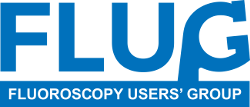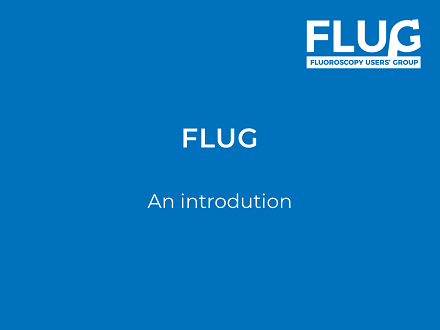

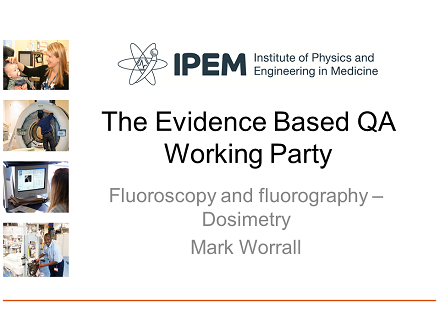
FLUG 2017 – IPEM Evidence Based QA Working Party – Fluoroscopy and Fluorography – dosimetry; Mark Worrall
Background
There is little evidence in peer reviewed literature to support the efficacy of many of the tests of x-ray equipment performed routinely by medical physics departments. Current guidance is based on the substantial experience of the members of working parties involved in writing IPEM report 91 and the IPEM report 32 series. The aim of this working party is to produce evidence that would support any future revisions of IPEM Reports 91 and 32. The specific focus of this workstream is on the efficacy of routine tests in fluoroscopy and fluorography.
Methods
A pro-forma for data collection was devised, tested and revised by the working party. The final pro-forma contained fields to collect data relating to all tests routinely undertaken on fluoroscopy and fluorography equipment. The fields were designed to accept simple pass/fail or the quantitative result, whichever was most appropriate for each specific test.
The pro-forma was developed in such a way that as much or as little information could...
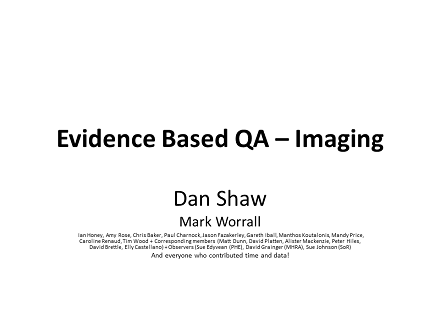
FLUG 2017 – IPEM Evidence Based QA Working Party – Fluoroscopy and Fluorography – image quality; Daniel Shaw
Background
There is little evidence in peer reviewed literature to support the efficacy of many of the tests of x-ray equipment performed routinely by medical physics departments. Current guidance is based on the substantial experience of the members of working parties involved in writing IPEM report 91 and the IPEM report 32 series. The aim of this working party is to produce evidence that would support any future revisions of IPEM Reports 91 and 32. The specific focus of this workstream is on the efficacy of routine tests in fluoroscopy and fluorography.
Methods
A pro-forma for data collection was devised, tested and revised by the working party. The final pro-forma contained fields to collect data relating to all tests routinely undertaken on fluoroscopy and fluorography equipment. The fields were designed to accept simple pass/fail or the quantitative result, whichever was most appropriate for each specific test.
The pro-forma was developed in such a way that as much or as little information could...
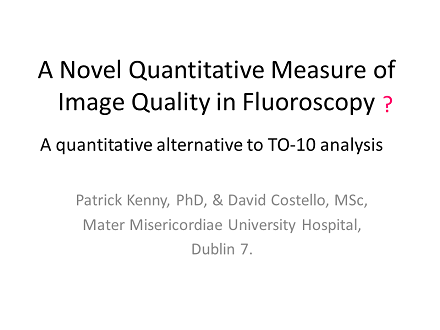
FLUG 2017 – A Novel Quantitative Measurement of Image Quality in Fluoroscopy; Patrick Kenny
Measuring image quality on modern flat panel fluoroscopy systems is challenging. Accurate measurements using the Leeds TO10 must use a small range of prescribed settings of beam quality (kV & added copper). Often these are not always easily achieved on newer systems. Also, TO10 analysis involves estimating the Threshold Contrast Index HT(A), which is a subjective estimate of the image’s signal to noise ratio. It is the inverse of the product of the square root of the disc area times its nominal contrast, as derived from Rose’s model of imaging. Finally, a typical measurement error of about 15% is associated with such an estimate of HT(A).
More recently we are beginning to use the NEMA XR-27 protocol in which ‘for-processing’ images can be used to calculate MTF, NNPS & DQE etc. However, while representing a welcome development, such measurements do not address the effects of image processing applied prior to image presentation. It is in some ways an interim...
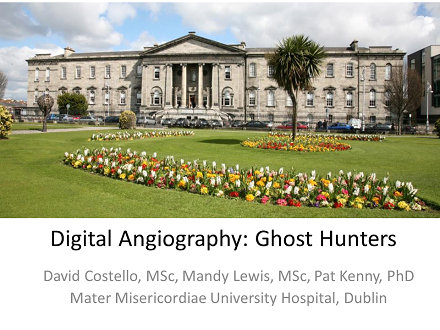
FLUG 2017 – Digital Angiography: Hunting for Ghosts; David Costello
Low dose Angiography (LDA) systems rely on significant recursive filtration (aka temporal averaging) to maintain image quality. The use of this type of processing is specific to the imaging application (cardiac, neuro, vascular…) and can be varied by the system vendor. In situations of rapid motion, such processing can have a detrimental effect on images obtained, producing temporal ghosting.
LDA enables the use of lower kV and mAs resulting in lower patient and staff doses. It also allows manufacturers to overcome output limitations when using smaller focal spots. While the benefits are clear very little work has been carried out in relation to the drawbacks of this approach. This work aims to examine the impact of recursive filtration on moving targets in LDA systems.
Common test objects such as the Leeds Test Objects do not allow for the dynamic assessment of Image ghosting. In this study, a modified NEMA Cardiology Phantom and an in-house linear motion phantom were used...
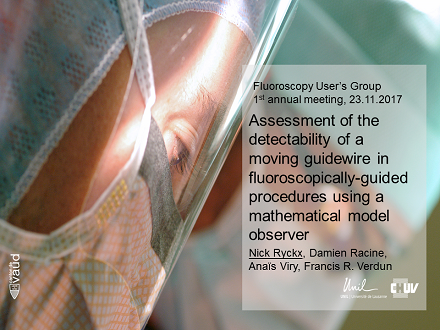
FLUG 2017 – Assessment of the detectability of a moving guidewire in fluoroscopically-guided procedures using a mathematical model observer; Nick Ryckx
Presentation to come
Background
Fluoroscopically-guided procedures are among the most irradiating medical interventions using ionising radiation. As such, a fair amount of pressure is put on reducing patient dose, either by adapting the protocols implemented in the units, or by heavy technical upgrades allowing for online image processing and subsequent patient exposure reduction. The downside is a potential loss in image information content, leading to either longer procedure times or, worse, increased volumes of injected contrast medium. To our knowledge, there is no existing quantity able to properly assess the visibility of moving structures in fluoroscopic images. This work proposes a new method to measure image quality using a clinically relevant detection task in dynamic conditions.
Methods
Our test object consists of a 3 mm thick and 250 mm wide PMMA square plate, with a 1 mm deep groove along one of the diagonals. The groove is used to straighten a 0.014” thick coronary guidewire. The plate is attached to a dedicated motion...
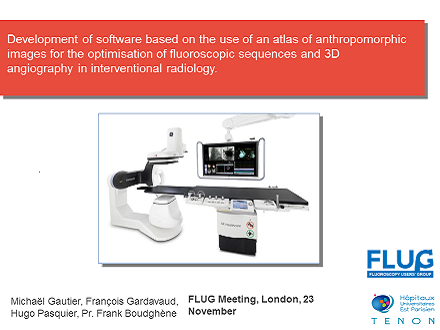
FLUG 2017 – Development of a software based on an anthropomorphic image atlas for image quality optimization in interventional radiology: initial results for 3D angiography; Michaël Gautier
Purpose
To provide a protocol optimization software helping radiologist to tailor image quality (IQ) in Interventional Radiology (IR) thanks to an anthropomorphic images atlas.
Method and materials
For the four most representative anatomic areas of our clinical practice (liver, pelvis, lung, spleen), five reference protocols were set-up in our interventional radiology system (Innova IGS 540, GE Healthcare, Buc, France) with different IQ/dose preferences from low dose to high Image Quality (IQ). These preferences were defined by adjusting the Automatic Dose Rate and Image Quality (ADRIQ) strategy, the detail level and the rotation speed for 3DA sequences. For these 20 protocols, 3D angiography images were acquired on an anthropomorphic phantom (PBU-60, Kyoto Kagaku). All acquired images were qualitatively validated by a senior radiologist. These images were implemented in a home-made software (ProtoEnhanceIR) in order to optimize protocols by displaying the anthropomorphic images and associated Peak Skin Dose (PSD). The radiologist has the ability to select the most suitable protocols in regard...

FLUG 2017 – Business Meeting; FLUG team
Elections due
The Chair (Jonathan Cole) is up for re-election. Nominations were invited from anyone else who wishes to stand.
Constitutional amendments
An amendment was passed to add a quorum for certain actions to the constitution.
...
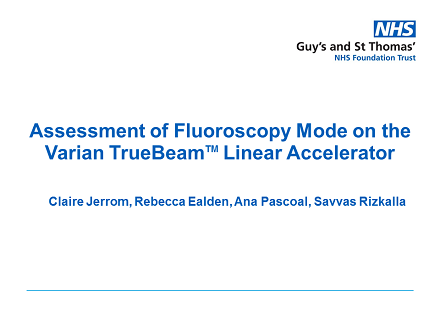
FLUG 2017 – Assessment of Fluoroscopy Mode on the Varian TrueBeam Linear Accelerator; Claire Jerrom
The X-Ray Imaging System on Varian TrueBeam Linear Accelerators can be used to acquire fluoroscopic images to aid radiotherapy treatment planning and verification. Six Varian TrueBeam units were installed in the Radiotherapy Department at Guy's Cancer Centre in June 2016. The fluoroscopy programmes were tested on three of the units during the commissioning period, and were deemed to be unsuitable for clinical use at that time due to the high skin dose rates and poor image quality.
The radiotherapy department planned to use the fluoroscopy mode to observe lung tumour motion by screening the patient for a period of several breathing cycles using a low frame rate and with the beam collimated to the area of interest in the lung. Screening would be performed in AP and LAT orientations prior to the delivery of each radiotherapy fraction.
Additional measurements were carried out in March 2017 to investigate the fluoroscopy programmes further, with the eventual aim of bringing these programmes into...
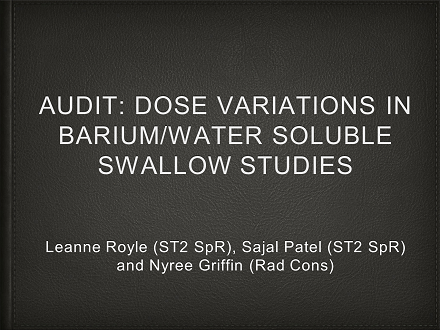
FLUG 2017 – Dose variation in Barium/water soluble swallow studies; Leanne Royle
Barium swallows continue to prove their usefulness in a wide range of diagnosis and within Guys and ST Thomas’ Trust are the most common fluoroscopy procedure performed. They are performed mostly by the junior registrars and discussed with senior consultants to come to a useful conclusion to aid in the diagnosis or ongoing management of the patient. There is a general protocol registrars use to complete a study, which we are taught early in our training. However this varies depending on the clinical indication and question to be answered. As fluoroscopy is a dynamic test, the patterns of practice change in real time depending on the findings of the study. As with any fluoroscopic investigation, screening time has to be considered alongside the need for diagnostic images.
Our project investigates the range of doses in over 400 barium/water soluble swallows performed within our trust over the period January to June 2017. We have reviewed the indications and protocols used with...
